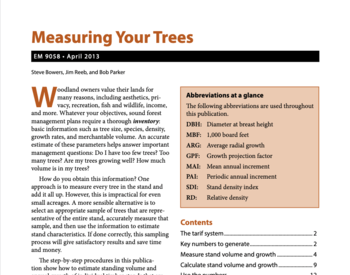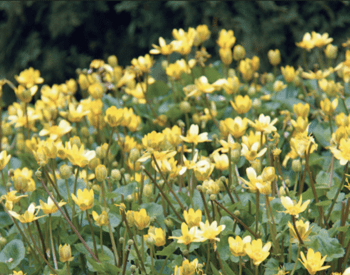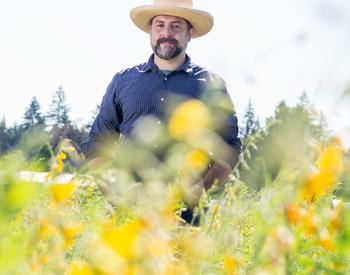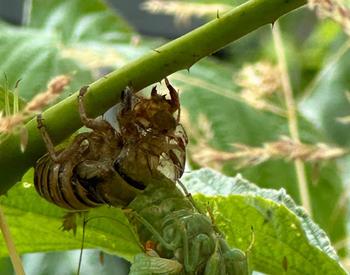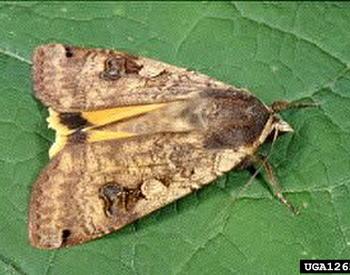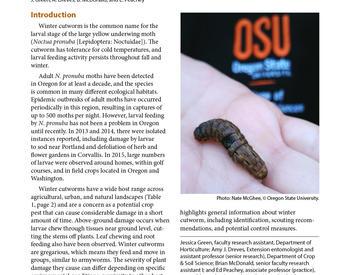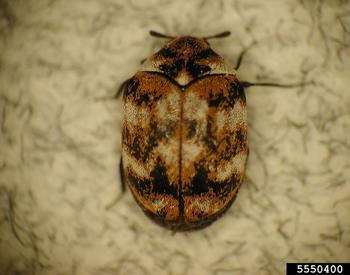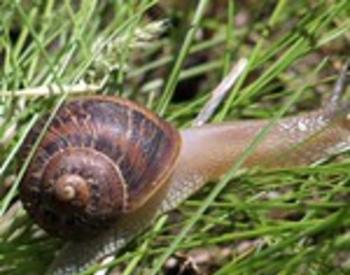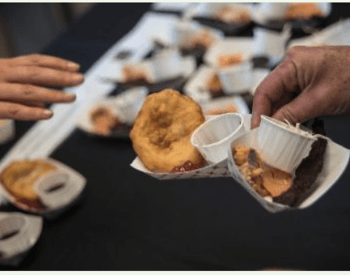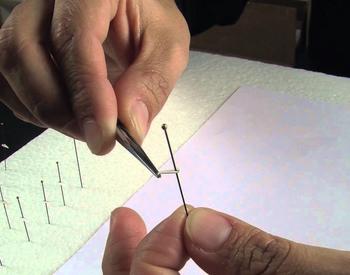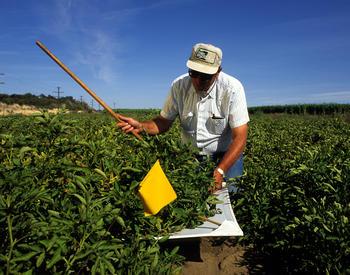Transcript
From the Oregon State University's Extension Service, you are listening to In the Woods with the Forestry and Natural Resources Program. This podcast brings the forest to listeners by sharing the stories and voices of forest scientists, land managers, and enthusiastic members of the public. Each episode, we will bring you research and science based information that aims to offer some insight into what we know and are still learning about forest science and management. Stick around to discover a new topic related to forests on each episode.
Did you know that the In the Woods podcast won an award? That's right. We've been nationally recognized by our peers as being one of the leaders in providing natural resources, content and education through a podcast. But what do you think?
Do you like the topics we've been covering? Are there topics we're missing that you'd like us to cover? How's the quality of the episodes? We've developed a short survey where you can let us know how you feel. Head over to our website @IntheWoodspodcast.org to access the survey. Or you can find a link in this episode's show notes.
The survey should only take about 5 to 10 minutes for you to complete. And when you're done, you'll have the option to enter into a drawing to win some In the Woods swag. We've got magnets, stickers, coffee mugs, and t shirts for you to choose from. We really need your help, so please take a moment to fill out the survey.
The feedback we receive will not only help with improving the podcast, but also help us in the Forestry and Natural Resources Extension Program to ensure we're reaching all our audiences. We look forward to bringing you more engaging content on a wide range of topics with guests from diverse backgrounds, experiences, and expertise.
From all of us at In the Woods, Thanks again for listening. Welcome back to another episode of In the Woods. I'll be your host today, Lauren Grand, Associate Professor of Practice and Extension Agent in Oregon State University's College of Forestry. Uh, there's a new mobster on the scene, the Mediterranean Oak Borer, or MOB, or some call mob for short.
And in this episode, we're going to talk all about this invasive insect and what you can do to minimize its effects on the landscape. And to help us learn more about this insect, I've invited Oregon Department of Forestry's state entomologist, Christine Buhl, back onto the podcast today. Welcome to In the Woods, Christine.
Hi, thank you for having me. So my hope is by the end of this podcast episode, our listeners will have a better idea of how to identify the damage caused by the species and some things they can do when they find it. But before we dive in, it's been a while since you've joined us, so give us a little bit of a background or history of, uh, who you are, what you do, and how you got excited about bugs.
Oh, yeah. Um, so I've been, um, working in entomology for about 20 years now. Um, I started at Oregon State University and just found entomology and kept following my nose on the various projects that range from forensic entomology, public health entomology, tropical, aquatic, etc. Um, and then I found my way to forest entomology after finishing grad school at University of Wisconsin and the state forest entomologist working with Oregon Department of Forestry.
Um, and I wanna talk a little bit about our crew. I'm on a four person crew where we have an entomologist, that's me, and then the pathologist that works with diseases and basic species specialist and an aerial survey specialist. And what we do is similar to your job, Lauren, as an extension agent, um, that we respond to clients, public, private, doesn't matter, across the state, um, diagnosing pests issues, um, that includes abiotic stressors, insects, diseases, et cetera, and then providing management guidance and also monitoring different pest issues from the plane and aerial survey we fly every year.
And then on the ground via trapping and observations. Just to try and improve the resiliency of forests across the state. Wow. That's a big job. Lots to do. A big fun job. Yeah, it sounds really fun. And that forensic thing in the beginning sounds like it gave you a lot of experience for trying to figure out from little details what's going on?
Yeah, definitely insects are everywhere and they provide a lot of clues for us and a lot of times they're indicating to us especially the job that I work in now that there are underlying stresses in the trees. So they often are not the cause of trees dying back But they're indicating that the tree is stressed by something else that we need to manage for. Ah, that's an important point.
Yeah, I think a lot of times we get phone calls from people that are like, Oh, what bug is killing my tree? I see all these bugs on my trees. You know, how do I get rid of them? And yeah, I think the really key thing that you pointed out was there's probably some other underlying issue that's making those bugs interested.
And quite often nowadays it's drought. So I usually say, no, it's not the insects, it's drought. But in what we're going to be talking about today, um, it actually is the insect, um, when you have an invasive species attacking our native species, sometimes they are the native species are unprepared to defend themselves against those pests.
Okay, so my, maybe my analogy of a gangster is a little bit appropriate. So, being aggressive of a beetle. Yeah. Okay, so let's get into the meat then. Um, so tell us a little bit about this insect, the Mediterranean oak borer, uh, where did it come from? So this insect, um, which oftentimes people think that pest insects are always really large, but this insect is a really tiny little insect that's about the, um, the size of a grain of rice or smaller, um, pretty much half the size of a grain of rice.
It's very small, but it vectors a pathogen that kills the trees. Um, and so, and I'll explain a little bit more about that, but it's not necessarily the insect that's killing the trees. It's this pathogen that it carries on its body that it uses that pathogen actually to feed its young. Um, but this insect, um, in its native range, it's spans all the way from Europe across North Africa into the Middle East, so it has quite a broad range.
Because it has that broad range, it feeds on a lot of different hosts. Um, a lot of different hosts within oaks specifically, and then a few other non oaks are worked in there as well. But in its native range, it's attacking trees that are already stressed. They're already dying because in a system where you have a native host and a native insect, they're used to each other.
They've co evolved over time. The host has the ability to resist or tolerate via defenses these insects. And so only when that host is weakened, can it be taken down. So it's very similar to when we get a cold. If we're a normally pretty healthy people, we get a cold, we can shake it off pretty quickly.
It's not going to take us down. But if we already have an underlying illness, a cold could be very detrimental. And so when these invasives come over to an area that they are not from, those hosts have not evolved with them. They cannot defend themselves against those insects. And so even hosts such as healthy oak trees can possibly succumb to um, this insect and the, the pathogen that it vectors because it's just not used to attacks from this insect, does not have defenses built up for, against this insect.
Okay, so, um, you mentioned that it, um, attacks oak trees. Does it attack all of our oak trees, or are there just a few that we need to be worried about? Yeah, so far, um, and there's, I want to stress in this point throughout this podcast that, um, Mediterranean oak borer, or mob as I'll continue to call it, um, there's a lot of unknowns here.
We know very little because... It's going to behave differently in the U. S. than it does in its native range. So we're starting from scratch learning about this beetle a little bit. Um, and it's only really been found in California and they came across it in 2017. They think it's been there since 2010s, but so it's still pretty new on our landscape.
We don't really know how it's going to behave and what we've seen thus far in Oregon is that we have a different Uh, complex of oak species on our landscape than California does. There's some overlap there, but, um, there might be some differences in what hosts are attacked in Oregon versus California or how the insect can actually damage, um, oaks that we have up here versus California.
So, what we have seen in California is that it typically will attack valley oak, but also blue oak. There's, uh, I think a single incident that California black oak, um, and then there are the way these trees are kind of divided is there are sections differentiating different types of oaks. So you'll have a whole group of oaks that are in the white section and some that are in the red section.
For example, so what we have seen is that the oaks within the white and sometimes the red sections are the ones that are getting attacked in Oregon. We have Oregon white oak, which is in the white section, and we have, um, California oak that is in the red section, um, California black oak. And so those are two species that are found in California that do get attacked, but not at the level that they are seeing in their valley oak and their blue oak.
And so we don't know if this insect, because it doesn't have valley oak or blue oak up here, it's instead having to rely on our oak species. Maybe that detriment might be a bit lower, but we do not know yet. So, um, you mentioned that the, the species is in California and that it's starting to be in a couple incidences here in Oregon.
Where in Oregon have it been found so far? So we first found it in traps, so Wyatt Williams, our invasive species specialist, sent out sentinel traps, um, along pathways that we would expect to intercept invasive species. So near shipping areas, for example, where things get imported and then the insects escape from those imported products.
And so in 2018, he found, um, a single individual in a trap that's in Multnomah County at Chinook Landing Park. Um, and then in years thereafter, trapping that same area. No more were found. However, um, we did start finding insects in other traps. Um, I believe starting in 2021, um, all the way up to 2022.
Um, they were found in Marion County, Multnomah County, Clackamas, and Washington counties, not in large number, um, but we were starting to find them in other areas, um, and there was really no clear pattern as to a pathway pointing to where more of them were coming from so we can determine how it got here.
Through DNA genotyping, however, of a few individuals, we found that they came from a German population. Um, which is different from the populations in California, so, uh, we don't think that our current mob populations have come up from California, um, they get transported via firewood, um, in interstate travel very commonly in some other products, um, but so far we have found that our population is from Germany, doesn't mean that we can't receive some from California, um, but we're trying to trace back to determine where they're actually coming from.
So those are the trap catches. And then in 2022, I went looked at a tree in Wilsonville that had a lot of other things going on with it. Um, some construction damage around the root base, some root compaction and various other pests and storm breakage. So it was really struggling. Um, and then we followed it into 2023 and it did have mob infesting it and that tree had large sections of branches dying.
It is still alive, but it's actively producing dead branches that are increasing. Um, and then there was a tree found in Troutdale, um, that also had been infested by mob and that died. And that was since taken down by the Forest Service, um, and covered until we can, uh, properly destroy it. But we're just trying to reduce the ability of those insect populations from escaping from that tree to surrounding oaks.
Um, now in Troutdale, that was a single tree where we could not see any oaks nearby. So we have no idea how they got into that tree. They just kind of stuck around there. Um, and then in Wilsonville, that was a single tree. But, um, since that initial find in 2022, we started mapping other finds in trees. Um, a lot of which are alive.
Um, they just have sections of the crown that have died back. So we have less than 30 trees so far that we've identified that are infested with mob all within the city of Wilsonville. And we are working with that city that's being very proactive and trying to mitigate the damage and minimize the spread of this insect.
Okay, so you alluded to this a little bit in that answer about, um, that some mob are transported through firewood, interstate travel, um, of people taking firewood with them, um, and how it gets here from other countries, and that you were sort of concerned or not concerned, but maybe questioning how it got into that single tree, um, with no other trees around it.
So how does the species move around? Are there other ways that it moves around? That people can avoid helping it move around? Yeah, so the three main ways that we've identified that invasive species kind of move around. First, they can arrive here via shipments. As commerce increases worldwide, a lot of products are shipped back and forth.
And so we sometimes receive products that are not treated. So for a wood boring insect that dives deep into the wood, they could be in pallets or packing material. Or sometimes milled products, um, that they make it through a heating process, for example. And so there are some standards that, um, people making these products have to follow in order to ship them overseas in terms of heating them sufficiently.
Um, that's not always done to the level that we need it to be done. Um, and then sometimes things just slip through. Um, we have some people that work very hard, um, at Customs and Border Patrol, for example, that are trying to find these insects before they can, um, leave from ships and, and shipments, um, they work really hard trying to find everything, but that's a lot of stuff that's coming through and it's easy to miss things.
Um, they get tucked away. So that's one way things can arrive in North America. Um, and in other countries, however, or in other continents, but they can also travel from state to state via the nursery industry. Um, and, uh, firewood is a big one. And so the things that we always suggest is buy it where you burn it.
Do not move firewood. Um, when you get to your campsite, buy the firewood there. Don't bring any from home. Um, typically we advise not to move firewood any more than 10 miles from from the source location. Um, that's always a good practice. And then we do work with Oregon Department of Agriculture, who, um, is our partner, major partner on this project.
And, uh, nursery regulations where things are inspected to avoid transport of pests. Great. And, I'm just like picturing people looking at ships, and these have to be really detail oriented people to just like look at all the cracks and crevices of ships and, you know, places where all these insects can hide, so good on them.
Thanks, for that work. Yeah. Um. Okay, so let's get a little bit more into this insect and, well, let's, let's talk a little bit about what signs, what signs might you see in an oak that's been infested or being attacked by this insect? Sure. First, I'll give a quick overview of kind of the biology, how the insect works, because then that alludes to kind of following that trail of, well, this is why these signs and symptoms are occurring or where they're occurring.
So, as I mentioned, it's a really tiny insect, um, you know, less than the size of a grain of rice. Very, very small. And they live together in a community, typically. And so, um, the female will land on the tree, burrow in, make a gallery, Um, they're laying eggs, the eggs are hatching into larvae, developing into pupa, turning into more adults.
That's just the general overview. But as I mentioned, this is an ambrosia beetle. It's a wood boring type of ambrosia beetle. It gets into the wood, typically hangs out in the sapwood, which is where the vascular tissues that are transporting and taking up water and nutrients. So really important. It's kind of like the veins of the tree, the most active living tissue.
So they're living in that sapwood. Cutting through making these very tiny galleries, however, they are planting fungus that's present on their bodies in these galleries and their young is feeding on that fungus. Um, that fungus is what's causing the pathogenic disease. So it is making the tree sick because it's clogging those vascular tissues or those veins that are translocating water and nutrients.
And so that's how it kills the tree. Um, once the insects get in, they stay there sometimes for multiple generations. Um, there's no reason to leave if the food is still good quality to grow their fungus. Um, so they'll just stick around in that same tree making generation after generation. And then once that's used up, they may leave and go to an adjacent tree.
They don't want to fly very far. They, you know, they don't have a lot of fat stores. They're very tiny, so they can fly further, especially if the food source isn't nearby, but they typically will stick in one area and kind of grow out from there. Um, and then when they are, um. You know, planting this fungus, um, it's like I said, it's, it's clogging those vascular tissues, so it's essentially girdling the tree, it's cutting off the abilities, uh, the ability of those vascular tissues of transporting water, and so sections of branches die, and so that's the first indicator, is once you know you're looking at an oak tree, if you see a whole branch that is dying, um, or a whole section of the crown that's dying, um, you might take a closer look because something is wrong with that tree, obviously.
It's not scattered throughout the crown. Usually they'll attack, you know, they start with one portion of that initial population has to attack, you know, one of the branches and then they can move down that branch into the trunk or an adjacent branch. Um, but it's not typically an overall thinning or just tiny little bits of dieback in the crown.
Those are from other things that typically do not harm the tree because it's so scattered throughout the tree. However, this insect causing that large scale dieback and whole sections of crowns, that's really visible that you'll all of a sudden see a whole section of the crown that's turned red.
Um, we're learning more about earlier symptoms before the leaves turn red, that this vascular disease, it's a vascular wilt, and so, um, in some hosts, you'll see kind of a droopy looking leaf, um, or maybe smaller leaves that are produced in that, um, initial stage, but, um, we don't know if, if our white oak is going to behave that way, um, we've started catching on once we see the leaves are already red, and so that, that large scale dieback of the crown, um, typically it takes, you know, a couple years to, um, after infestation to even see that.
And from there, you want to look a little bit more closely for a pale boring dust, also called frass. As the insect digs into the wood, it kicks out this white sawdust looking material. Um, that could be in the bark crevices around the base of the tree, even caught in spider webs. Um, you want to take a closer look there.
Um, there are other insects that do this as well. Um, typically they won't cause large scale dieback of the crown. So if you see a large scale dieback of the crown, the, that white boring dust, um, you want to report that to the Oregon Invasive Species Online Hotline. Um, we want to know about it. We want a picture.
We want a location. We want your contact info. We are following up on all of those leads. There are a couple of other things that you can look for. Um, sometimes you might see the insect itself crawling around the outside, but unless you're an entomologist with a microscope, you're not going to figure out, um, definitively, it's mob.
But they make these galleries that are pretty distinct. It branches out, so they start at the exterior of the tree, and then they travel forward and making this kind of like, um, it looks like a tree. It's a branched gallery that's only entering the sapwood, typically, and it's black stained.
Now, there are other ambrosia beetles that get into oak that also make these black stained galleries. Their galleries look slightly different. They typically don't overlap and join up as mobs does. Um, but again, that takes, um, a keen eye to look at that. Um, but if you do see a tree with dieback in the crown, um, you see that frass.
You may look around if there's some dropped branches you can take a look at to see if you see those black stained galleries in those dropped branches. Um, we're not suggesting people cut into live trees to look for those galleries, um, but there, if there are exposed portions or the bark has, um, been broken off from the exterior of the tree, you might look and see if you can see a black gallery there.
But those are the defining signs and symptoms for mob. Um, we also have a fact sheet on the Oregon Department of Forestry Forest Health page called Oak Pest. Um, to kind of differentiate other things that get into oak that could be confused with mob, but anytime you see that larger crown dieback, um, that's something you want to get a little closer to the tree and, and take another look at to see if there's something else that could be explaining that dieback.
Okay, so you're not recommending that if people see a whole branch die. Or a group of branches die, to sort of cut them off to, would it, would it help the spread, you know, would there be too much damage to the tree that would cause it stress by cutting those branches? Or could you cut those branches off and, and discard them and potentially reduce populations?
Is that something that people could do? Yeah, that's a really good point. So, um, we are still developing management strategies there that are going to be effective. We do have some ideas as we work with our California partners about some things that might work. We're not putting everything out just yet because we want to make sure they really do work before we advise people to go through the expense and the labor of doing these things.
But one thing that has been bandied about is if you see the initial start of die back of the crown and. And be aware, there are many gall making insects, um, that squirrels go and dig after that will make little pockets of dye back in the crown. You'll see, um, here and there are little scattered bunches of red leaves scattered throughout the crown.
That is not mob. We don't want you to remove that material. That could be more damaging to the tree. Um, there's no need to remove branches that are perfectly healthy. Uh, those leaves will drop off and then be refleshed the next year because it's a deciduous tree. It doesn't harm the tree. But if you are seeing a whole branch that is dying back. There is a possibility that you could remove that branch below the point that you see those black stained galleries so below that um, you might think that there might not be mob and you could cut below that point and burn or chip that material on site immediately to destroy it and you might be able to head it off.
However, there might be something in that tree that's really attracting that insect and they're going to keep hitting it, meaning there might be some other stress in the tree. It's important when you're trying to determine if mob is in a tree to clear out any other possible options as to what could be harming the tree.
There are many other things. Oaks are long lived, especially Oregon white oak can live up to 500 years, so it's exposed to a lot of conditions over those years. Storm breakage is very common, especially for large unsupported branches, um, heading into, you know, winters. Or we have these erratic storm events, it might be who the landowner to preventatively remove large unsupported branches that have the potential to break off, but removing too much of the crown is going to be damaging so you really have to weigh it in terms of what is really going to help the tree now versus the long term. But looking at the tree, looking for other signs and symptoms of other things that might be going on, like I mentioned, if there's construction nearby, if the tree is growing in a tight spot where its roots are under sidewalks and roads, it's prone to be damaged just by compaction.
Um, and so that could be a simple indicator of why a tree is dying back and it's not mob at all. There could be previous storm damage where the branches break, you see these fungal conks and these rotten areas in the tree. That right there could be the reason why a tree is failing, but we could also be seeing those things in combination with mob.
So, um, I definitely suggest looking for that white boring dust first, um, before automatically determining if it's mob or not. Um, but if there's any concern, definitely reporting it to the hotline is advised. Um, and then back to management, burning and chipping on site once you have a confirmed mob infestation is advised.
We realize that's really hard for some people, it's expensive. These oak trees can get really large, um, so we're working on some more management strategies that might be more efficacious down the road. So, but right now it sounds like prevention is your best defense as as usual. Yeah, I feel like, you know, a broken record.
Yeah, right. And prevention, prevention, prevention. Right. And the, the healthier you can make your trees, the better they're going to be able to resist and tolerate even invasive insects. They may not be able to resist them forever, but it gives them more time, gives us more time to act. And so one of the preventative measures I already mentioned, removing really large unsupported branches that are, um, prone to breaking off in subsequent storm events.
Um, but also one of the other things that we're kind of advising, we don't have real hard numbers on it yet, but it's never a bad idea. Despite the fact that Oregon White Oak is a really drought tolerant tree, we've had some pretty extreme summers, a lot of droughty years back to back, trees are stressed.
And so if they could be given one or two plugs of water during the hottest parts of the summer, and we do have a watering guide on our website. Um, a long, slow, deep watering, um, maybe once or twice in a summer could really help a tree make it through those harder times, making it more resilient to pests like this.
That's good advice. And we'll be sure to add, um, links to the watering guidance and your mob fact sheet on our website too. Great. So, I love this call to action that you had for everyone was to check out, you know, check out their, their crown and make sure that they're not seeing any signs and if they do see signs to call the invasive species hotline.
So, because you want to know about it. Um, is there any other actions that one should take if they are considering that their tree might have mob or, um, anything like that? Sure. Yeah. So the first question we usually get asked is what insecticide can I treat with? Um, that's something we're still studying.
There's some preliminary evidence that an insecticide plus a fungicide might be effective. The insecticide obviously to prevent the insect from attacking in the first place. But if it does, um, just in the very initial stages, the fungicide could kill the fungus at its vectoring. And that's really the culprit of the tree mortality.
We do not have enough information to, um, advise this as a treatment plan. There are a lot of reasons why biologically it may not work with this type of insect that does not feed on wood because it's just not getting the delivery of the pesticide once it's moving through the wood, it's feeding on the fungus instead. Um, so a lot more research needs to take place there we are actively working with our California partners with Oregon State University researchers um, and also at this time the city of Wilsonville, um that is going to lend us some of the evidence that they are obtaining and let us monitor some sites where they are testing some insecticides.
Now there are non target effects of insecticides. So you want to weigh, um, is this going to be something that you want to employ at your site? It can also affect other insects that are not pests that are underneath the bark or in the wood. But if it's weighing against, um, losing your tree, it potentially could be the best option.
We don't want to lose these long life trees. So more to come there. Um, but usually there is not a silver bullet to, um, fix any pest, and if there were, it is just, uh, to keep the tree healthy in the first place. Um, so more to come right now, we have all the preliminary information that we need to go on for management, but we're going to be producing a lot more information.
Um, we as in Oregon Department of Forestry, Oregon Department of Agriculture, U. S. Forest Service, APHIS, Oregon State University, you know, we've all been working together with Emerald Ash Borer. We know the template, we know the plan, we know the players, um, so we're all working together to come up with management guidance as soon as we can, and then we'll be providing it on all of our respective channels.
Oh, I hate to say that you guys are seasoned pros now, we don't want to say that because we don't want these invasive species to cause these issues in our forests, but I'm glad that you have some experience so that we can hopefully nip it in the bud sooner than later. Yes, yes, and you know the sky is not falling, um, we'll always have invasives.
New invasives on the horizon, um, so it's good that we have these plans together. The right folks are talking to each other. We can act very quickly. Um, that's really important. If there's one thing that we really should be fearful of, it's more so drought stress on trees. And, um, future planning for that.
That is the larger thing that's harder to tackle. Um, but keeping in mind, just keeping our trees healthy on the landscape, they're going to be able to withstand a lot of things out there. We just need to plant the right thing in the right place. I know, Christine, it sounded like you're asking me to get you back on this podcast.
Anytime. We like to get the information out there to the folks that are actually seeing things on the ground. Okay, well, um, is there anything else that you feel like we didn't talk about that's really important for our listeners to know? Um, at this time, no. There's a lot more information that we're developing.
So, um, just stay tuned. Uh, we'll be producing a lot more of that information, as I mentioned, via multiple channels. Okay, great. Well, thank you so much for joining us today, Christine. Thank you so much. It's good to know that you guys are hard at work to help us all save our oaks, um, as this insect starts to make its way through our landscape.
Hopefully it'll be a lot slower than faster. And, um, again, if you are a concerned community member and you think you might see signs of mob. Feel free to put that information on the invasive species hotline so we can have an expert go check it out. Um, and as you were listening today, if any other questions came up or we didn't cover a specific topic related to forest insects or mob that you were hoping we answered, uh, drop us a comment or send us a message on our website at inthewoodspodcast.org. But don't leave us just yet. We've got our lightning round coming up.
Okay, since we already know your favorite tree from the Emerald Ash Borer episode, what's your second favorite tree? I don't even remember what tree I said. I can think of my top three favorite trees. We'll pick one of your top trees, and if it's the same, that's okay. I love, I love the Pacific Madrone. I think that is one of the most beautiful trees, um, but Redwoods are also up there.
They both have the first spot, but I do want to put one more that's become my, this is my favorite tree at this time, because as we move into droughtier climates, I'm really, um, advising folks to switch, for example, Western Red Cedar out for Incense Cedar in some really droughty areas. That's become my new kind of front runner tree that is just so durable.
It's beautiful, grows fast, beautiful wood. Um, that's, that's kind of like my favorite tree at the moment, but man, it's hard to choose. We have so many beautiful trees. That it's really hard. Yeah. Incense cedar is pretty cool. And it grows in rocky, shallow soil. Yeah. Yeah. Ideal. What a trooper. Okay. Um, besides your magnifying glass or your loupe, what is the most interesting tool that you carry out in the field with you?
Oh, it's not interesting at all. Um, but to me it's so useful. So, um, I carry these large test tubes. They're called falcon tubes and they're like the length of your hand. Um, they're about two inches wide at the opening. Well, maybe more like one inch wide at the opening, very wide. And they're just large enough that I can put a forcep in.
And so, um, and sometimes some other materials that I need to carry. So what they are is like a little carrying case with things that I need to collect the insect. But then I can collect the insect and put it in the tube. And because they're plastic, they don't break. So I can even put glass test tubes that have ethanol in them, for example, if I need to preserve something inside the falcon tube with the forcep.
And that little three pack gets me through collecting anything. That's become my favorite tool. That's great. So all you kiddos listening, because there's so many kids that listen to this podcast. You never know. Now when you really want to look at bugs. We're right, all kids at heart, right? Looking at bugs.
Collect the bugs and check 'em out in those falcon tubes. Cool. Yeah, I, you know, I always say like, people ask, how do you get into entomology? And I'm like, well, I'm a kid that never grew up always poking around in the dirt. You know what, actually I, I told you that you weren't allowed to talk about your magnifying glass 'cause I just assumed that all entomologists pick that.
That's actually, I remember. Yeah. Now that I'm remembering, I think you actually talked about tools that you make. Yeah, you might have talked about some of these things to yourself. Yeah. Anyway, that's okay. And then, um, lastly, what other resources besides, you know, your Forest Health website, which has great publications and the invasive species hotline.
Do you have any other, um, suggestions for where people can go to get more information about this particular insect or, um, invasive species or entomology? Yeah, the Oregon Invasive Species, um, website is actually a great resource. It has a lot of fact sheets, um, for various invasives that span from insects to weeds.
Um, so that's a really great resource. Um, I just would caution people, when you go Googling, it's kind of like, you know, when you're looking at WebMD or just looking for symptoms of something you're sick with, really pay attention to your source material. And quite often, if it's produced from a university or, um, a state or federal agency that's involved in natural resources, a lot of that stuff is fact checked.
That stuff is typically, um, right on point. It's current. Um, we do pay attention to these things to update them as we go. Now, we're not perfect. We do make mistakes. But those are really good resources. Um, just going to the website for your local municipality, natural resource divisions, or state or federal divisions, and universities.
Um, that's where a lot of really quality of product is put out and usually it's in a form that people can understand. They don't have to go digging through research papers. We try to read that stuff and distill it in a form that people actually wanna read. Um, and, and it actually makes sense and we get to the point, rather than giving you p values and how significant this finding was. Even I get bored reading that. That doesn't tell me how do I need to manage for my landscape.
So we try to glean that information and distill it for the broader public to make it more user friendly, um, shorter and more interesting. That's good advice. Yes. I mean, you don't want to.
Most the regular person doesn't want to read about how the data was collected. I don't want to read about it. Statistical policies. I don't need to know how the sausage is made every time. Good point. Okay. Well, always such a good time talking to you, Christine. Thank you so much again. Thank you. Thank you so much.
Um, okay. Well, that concludes our episode of In the Woods. Thanks so much for listening and join us again in a couple weeks to explore another topic on Oregon's amazing forests. But until then... What's in your woods?
Thank you so much for listening. Show notes with links mentioned on each episode are available on our website @inthewoodspodcast.org. We'd love to hear from you. Visit the Tell Us What You Think tab on our website to leave us a comment, suggest a guest or topic, or ask a question that can be featured in a future episode.
And give us your feedback by filling out our survey. The In the Woods Podcast is produced by Lauren Grand, Jacob Putney, Scott Leavengood, and Stephen Fitzgerald, who are all members of the Oregon State University Forestry and Natural Resources Extension team. Episodes are edited and produced by Kellan Soriano.
Music for In the Woods was composed by Jeffrey Hino, and graphic design was created by Christina Friehauf. We hope you enjoyed the episode and can't wait to talk to you again next time. Until then, what's in your woods?
In this episode, Lauren Grand is joined by Christine Buhl to discuss what the Mediterranean Oak Borer is, where it came from, and ways to identify infestations and prevent them from spreading.

